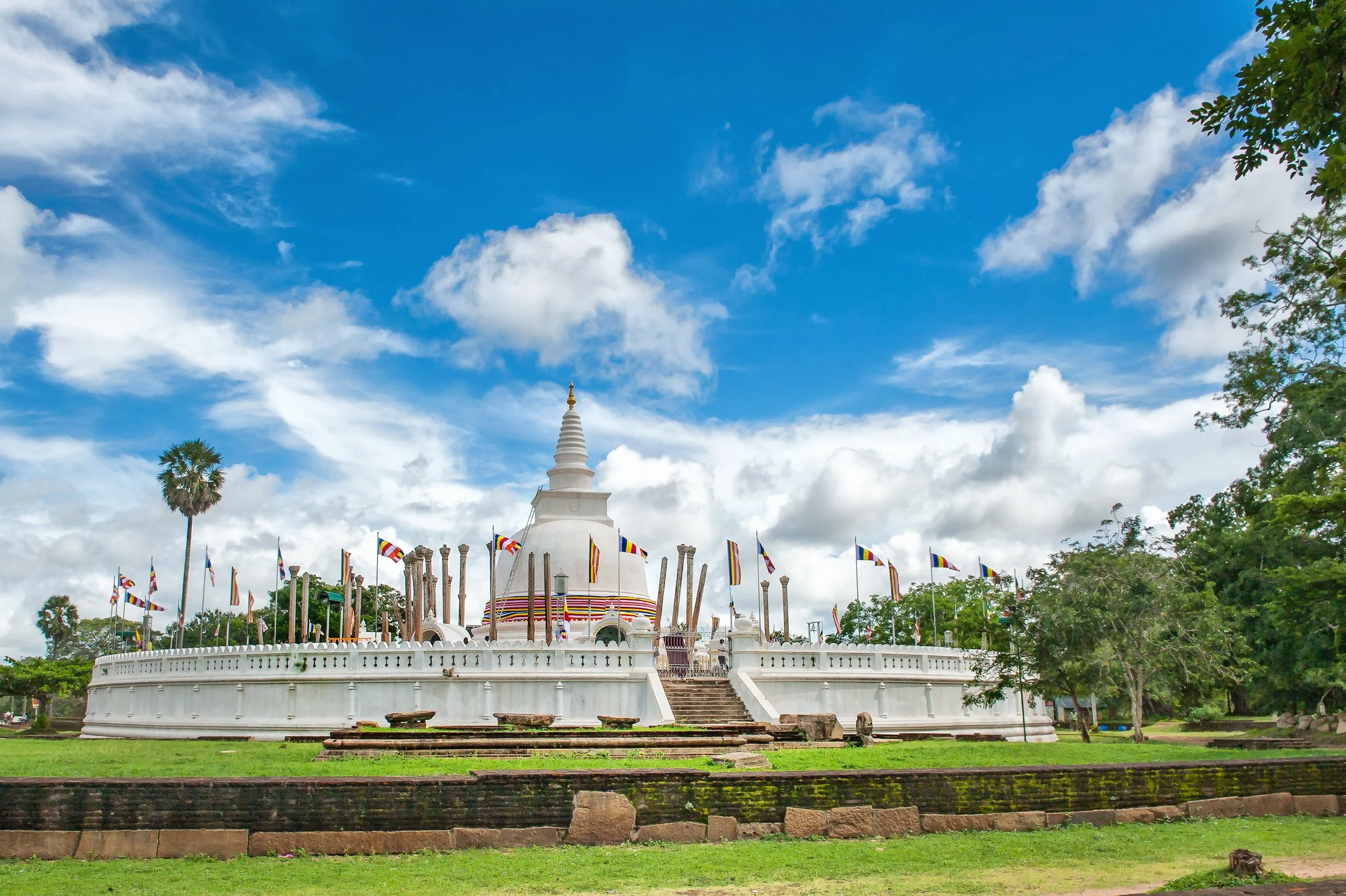Anuradhapura Part 3: Thuparama & Lankaramaya
At a Glance
Continuing through the ancient city of Anuradhapura, we stop at Thuparama (A,S) the city's original stupa, and continue on to the small stupa of Lankaramaya, related to two legends associated with King Walagamba.
Thuparama (A, S)
This stupa, said to contain the Buddha's right collar bone, was the first stupa constructed in the town of Anuradhapura, and is closely associated with Buddhism's arrival to Sri Lanka.
The Story
According to the legends, the Thuparama (A, S) was the first stupa built in the ancient city of Anuradhapura.The name Thuparamaya comes from “stupa” and “aramaya” which is a residential complex for monks. King Devanampiyathissa built this bell-shaped stupa at the request of Arhat Mahinda. The great arhat had informed the king that it was necessary to bring relics of the Buddha to have a support for offerings and veneration. He instructed the king, “If we behold the relics we behold the Conqueror.”
The king readily agreed to build a stupa, and Arhat Mahinda sent forth messengers to obtain relics. For the Thuparama, he specifically requested the right collarbone relic of the Buddha. Previously, the gods had worshipped this relic, in the heavenly Culamani-cetiya, but the arhat knew of the Buddha’s prediction. According to the Mahavamsa, the Buddha himself had foretold the transfer of the relic as well as its miraculous display,
“My right collar-bone, if it be laid in the Thuparama, shall rise in the air and perform the miracle of the double appearances. ”
The Mahavamsa then relates how, after the stupa was constructed to the appropriate height,
“Amid this assembly the relic rose up in the air from the elephant’s back, and floating in the air plain to view, at the height of seven talas, throwing the people into amazement, it wrought that miracle of the double appearances,’ that caused the hair (of the beholders) to stand on end, even as (did) the Buddha under the Gandamba-tree. By the rays of light and streams of water pouring down therefrom was the whole land of Lanka illumined and flooded again and again.”
After centuries of neglect and jungle growth, today’s pilgrim finds remains of four concentric circles of stone pillars around the stupa. These are the traces of the former 1st c. CE ‘vatadage’ (a Sri Lankan term for a unique structure known in Pali as a thupaghara), a circular relic shrine for the stupa. Originally 176 pillars supported this shrine and it would have had a wooden roof. The belief is that the walls would have been highly decorated with lessons from the Buddha’s life and teachings. The museum of Anuradhapura contains a model which gives the modern pilgrim an idea of how the relic would have been presented historically.
This stupa was destroyed from time to time, but during the reign of King Agbo II it was completely destroyed and then was restored. As a result of several renovations over the years, Thuparamaya currently has a diameter of 18 m at the base. The dome is 3.45 m in height from the ground and 50.1 m in diameter.
On the left of the Thuparamaya, there are remains of an ancient construction belonging to the stupa. This may be the remains of a construction also built by King Devanampiyatissa known as the Meghagirivihara, a monastery belonging to the Abhayagiri sangha. According to the Dathavamsa and the Dalada Sirita, it may have been constructed specifically as the first shrine for the tooth relic of the Buddha.
Only fifty meters from the Thuparama lies a small stupa identified as the Padalanchana Cetiya. It is also known by the names Sila Cetiya or Digha Stupa and was originally built by king Lagnatissa (119-109 BCE) to enshrine a footprint of the Buddha.
According to the Dipavamsa, the Mahavamsa, and the Mahabodhivamsa, the Buddha placed his foot print at this site as he rose to return to India after his 3rd visit to Sri Lanka. The Mahavamsa records this place as one of the four places where all the buddhas of this aeon left sacred foot prints. Kakusanndha, Konagamana, Kassapa, and Gautama Buddha all chose this very spot to leave a trace before departing Sri Lanka.
The restored stupa is built on a circular platform. A flight of steps decorated with moonstones, and balustrades lead up to the platform.
Lankaramaya (A)
Lankaramaya (A) is a small stupa also located in the sacred city of Anuradhapura. According to the historical records, soon after prince Walagamba (Wattagamini Abhaya) ascended monarchy, South Indian invaders attacked the Anuradhapura Kingdom. King Walagamba couldn’t contain the attack and had to retreat. While fleeing for safety, he hid in a place called “Silasobbha Khandaka.” Fourteen years later, King Walagamba regained his throne. Legends state that after regaining his throne, he built a stupa on his refuge site.
Another version of the story relates that while King Walagamba fled, he was almost captured by enemies since his carriage was too slow. To lighten the wagon so the king could survive, his brave queen Somadevi descended and let the king flee. Therefore, after regaining his throne, King Walagamba built a stupa called ‘Somaramaya’ as a tribute to her courage. The structure is said to contain jewels belonging to the queen Somadevi. The stupa is also called ‘Manisomaramaya’. Some believe ‘Somaramaya’ later was renamed to ‘Lankaramaya.’
Coordinates: 8° 22′ 0″ N, 80° 23′ 0″ E

